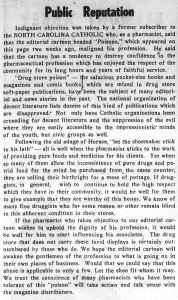Primary Source Set
Analyzing Political Cartoons
One of the ways that newspaper publishers express their views is through political cartoons. This editorial form became popular over the 20th century for the way it can quickly and forcefully deliver a viewpoint to its audience—particularly in decades when not all adults could read. This primary source set uses examples of political cartoons from school and community newspapers to show how the form has evolved over the last 100 years.
Proceed with caution and care through these materials as the content may be disturbing or difficult to review. Please read DigitalNC’s Harmful Content statement for further guidance.
Time Period
20th Century
Grade Level
9 – 12
Transcript
North Carolina Catholic (Nazareth, N.C.), June 5, 1953
The North Carolina Catholic comes from Nazareth, a Catholic community in Raleigh. This paper circulated for Catholics all over the state since, in 1953, all of North Carolina was within the Diocese of Raleigh (a diocese is the district of one bishop). The “Poisons” cartoon, published on May 22, shows a pharmacist making medications at his work bench in a drug store—which looks different from the drug stores of today. The article criticizing the cartoon was published two weeks later.
While the cartoon and the response are most critically focused on the magazines in the store (which read “Life in a Cesspool,” “Sin Above All,” “Pornographic Weekly,” etc.), these titles allude to a larger social issue. In the early 1950s, there was some experimentation with hormonal birth control (the FDA approved the first contraceptive pill in 1960), which would allow people greater freedom to have sex, especially outside of marriage. The Catholic Church was one of the strongest opponents of contraceptives, which may be part of the reason that this cartoon targets pharmacists specifically.
Contributed to DigitalNC by Catholic Diocese of Raleigh
Nazareth, N.C. (now Raleigh, N.C.) (Wake County)
Background
Many newspapers in the 20th and 21st centuries include editorial sections designed to make arguments or give opinions about topics in the news. One way for newspaper editors to present an opinion is through political cartoons. While these cartoons can be funny and entertaining, their primary purpose is to quickly make an argument about a political or social issue. Political cartoons can be found in all kinds of newspapers published in many different countries and can be used to address any issue that the audience of the newspaper recognizes. Many times, the artists address polarizing issues with cartoons or push the boundaries in an effort to evoke a reaction from readers.
Political cartoons often use some of the same rhetorical devices as written articles, including irony, symbolism, and analogy. Cartoons also have their own rhetorical devices, such as exaggerating characteristics of a particular person and labeling things to tell you what they represent. Sometimes, the meaning of the cartoon is made clear through a short title or caption. Additionally, understanding political cartoons usually requires knowing their contexts. Many of them contain representations of famous people or references to historical events. It may also help to know the intended audience of the newspaper.
Note: Some political cartoons depict stereotypes that may be uncomfortable to see. While the examples in this set avoid offensive imagery as much as possible, other pages of these newspapers may include it.
Discussion Questions
What do you see in this cartoon? Who are the characters? What are they doing?
What rhetorical devices is this cartoonist using? What elements are exaggerated or humorous?
What is the argument the cartoon is making? How do you know?
What does this cartoon tell you about this newspaper? Who is their primary audience? What viewpoints do they want to convey?
Do you find the cartoon’s point persuasive? Why or why not?
This primary source set was compiled by Sophie Hollis.
Updated January 2025
